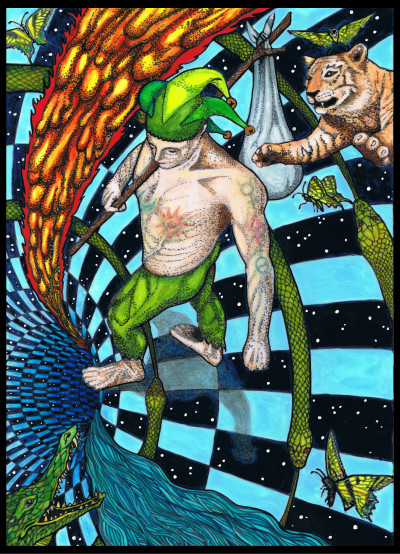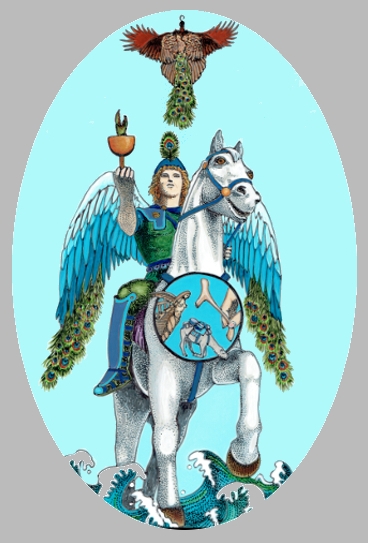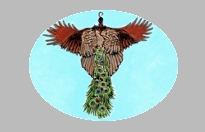Matter and Spirit: Deconstructing the Court cards and our Solar Year
Part V of XVI, the Knight of Cups: Parzival’s Quest and the Rites of Spring
This is the story of Parzival’s great quest for happiness. He faces trials and moral perils, but after passing through the Rites of Spring, he spies ahead the Well at the World’s End. He has a vision of himself there where he can drink from the sacred spring, and achieve the Grail.
The tarot Knight of Cups rules the heavens from the last decan of Aquarius thru the first two decans of Pisces, or 21 degrees Aquarius thru around the 20th degree of Pisces. Pisces is a somewhat passive sign, and very watery. But this is a Knight, and all Knights are associated with the force of Fire. Fire of Water is a strange combination; you could call it the “Force of Form” which doesn’t exactly feel comfortable. Water is mostly seeking calm, while Fire is instinctually swift and active.
The Knight of Cups is associated with Hexagram 54, the “Marrying Maiden”. The image is “Thunder over the lake: The image of The Marrying Maiden. Thus the superior man understands the transitory, in the light of the eternity of the end.” Keeping sight of the goal, while understanding the transitory nature of all things, is one of the lessons of Pisces. The hexagram reads:
‘The maiden marries: setting forth to bring order – pitfall.
No harvest in having a direction to go.’
While at first we may wonder what this marrying maiden has to do with a Knight, remember that the Knight of Cups is setting forth on a quest. Marriage is symbolic of the fulfillment of his destiny. Along the way, there are pitfalls. But what about “No harvest in having a direction to go”? Ultimately, his goal is Happiness. Sometimes though, we don’t quite understand what will truly make us happy. We think we know what we want. But sometimes what we thought was beautiful didn’t have the real beauty. If we are lucky, Fortune smiles upon us and brings us what we need to be happy instead.
‘The Emperor Yi marries off the maiden
The first wife’s sleeves were not so beautiful as the junior wife’s sleeves.
The moon almost full.
Good fortune.’
The Book T description of the Knight of Cups reads: A BEAUTIFUL, winged, youthful Warrior with flying hair, riding upon a white horse, which latter is not winged. His general equipment is similar to that of the Knight of Wands, but upon his helmet, cuirass and buskins is a peacock with opened wings. He holds a cup in his hand, bearing the sigil of the scale. Beneath his horse’s feet is the sea. From the cup issues a crab.
The crest of the tarot Knight of Cups is the peacock, with opened wings. The peacock, with it’s iridescent plumage, symbolizes the active, fiery part of water as it sparkles and fluoresces. These are the churning waves and driving rains, the newly discovered springs that gush forth, and the power of water as an alchemical solution.
As Fire of Water, this Knight is creative and inspired, tuning in to the vibrations he receives. He is a sensitive, artistic soul and has a certain poetic gentleness, almost otherworldly in the purity of his divine quest. He believes in his visions. The Knight of Cups is the swift rain, and the briefly overflowing stream from the snowmelt. Pisces is the last sign of the zodiac. His waters don’t run deep, but they have motion. The Pisces season heads towards the vernal Equinox through the last degree of Pisces, the Well at the World’s before the Aries point where things begin again. The last degree of Pisces is the vision of the place the visualizer visualizes. It’s the vision or inspiration of a goal or an ideal that molds our lives. This Knight doesn’t have that last degree of Pisces in his purview, but it is in sight, and the Graal he chases.
As the last and most mutable of mutable signs, the fish sometimes lack direction, swimming lazily back and forth with a certain degree of disinclination to rouse. But the Knight of Cups is receptive to inspiration, and that keeps him moving towards what he desires. As the old souls say, Spring always comes. Perhaps the crab peeking from his cup is an indication that he pursues, or should pursue, his goal indirectly, “without lust of result”, sidling as the crab, yet always moving like the fish he is.
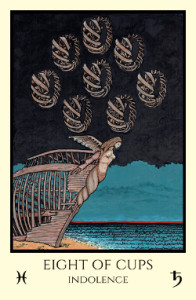 Looking at the first decan of the sign of Pisces in his domain, we have the Eight of Cups, the Lord of Indolence (Abandoned Success). On every quest there comes a moment of losing heart, a dark night of the soul where we lose pleasure in everything. Our will to continue is thwarted. The ship runs aground, and the cups don’t hold water. We are emotionally unfulfilled and not motivated to continue. What should be moving and flowing, has become dry and rigid. The Knight of Cups on his quest must realize this for the danger it is, and not abandon the ship.
Looking at the first decan of the sign of Pisces in his domain, we have the Eight of Cups, the Lord of Indolence (Abandoned Success). On every quest there comes a moment of losing heart, a dark night of the soul where we lose pleasure in everything. Our will to continue is thwarted. The ship runs aground, and the cups don’t hold water. We are emotionally unfulfilled and not motivated to continue. What should be moving and flowing, has become dry and rigid. The Knight of Cups on his quest must realize this for the danger it is, and not abandon the ship.
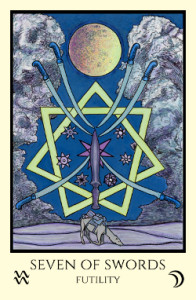 The other danger on his quest is shown by his shadow card, the Seven of Swords, Lord of Futility (Unstable Effort) which is the last decan of Aquarius. It shows how the Knight of Cups can collapse and give in to a sense of Futility when he is outnumbered and overwhelmed. Here there is disenchantment, and frustration that things are not going his way. Rather than be deceptive, he should be more clever than his opposition, and use that hidden Aquarian power. Instead he is in danger of giving in to passivity, figuring if he doesn’t actually try it cannot be said he failed. Yet this is not his true nature, and should be avoided as his Will is sacred, and should not be squandered.
The other danger on his quest is shown by his shadow card, the Seven of Swords, Lord of Futility (Unstable Effort) which is the last decan of Aquarius. It shows how the Knight of Cups can collapse and give in to a sense of Futility when he is outnumbered and overwhelmed. Here there is disenchantment, and frustration that things are not going his way. Rather than be deceptive, he should be more clever than his opposition, and use that hidden Aquarian power. Instead he is in danger of giving in to passivity, figuring if he doesn’t actually try it cannot be said he failed. Yet this is not his true nature, and should be avoided as his Will is sacred, and should not be squandered.
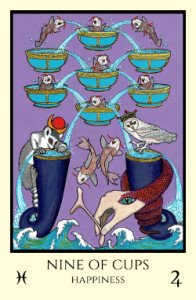 If he succeeds in passing these trials, the cup of happiness awaits. The middle decan of Pisces shows his goal, the true goal, as by the time we get to the Ten of the suit of Cups, it is overripe, and ready to pass away. This is the Nine of Cups, Lord of Happiness. Fortunate Jupiter, the ruler of both the decan and the sign of Pisces, offers a drink from the mazer, and the Merrythought grants the Wish. It is a Nine, the penultimate and thus fullest expression of Water, that of emotional satisfaction. The Nine of Cups is often called the Wish card, because when it appears, the heart’s desire is granted, the Holy Grail achieved.
If he succeeds in passing these trials, the cup of happiness awaits. The middle decan of Pisces shows his goal, the true goal, as by the time we get to the Ten of the suit of Cups, it is overripe, and ready to pass away. This is the Nine of Cups, Lord of Happiness. Fortunate Jupiter, the ruler of both the decan and the sign of Pisces, offers a drink from the mazer, and the Merrythought grants the Wish. It is a Nine, the penultimate and thus fullest expression of Water, that of emotional satisfaction. The Nine of Cups is often called the Wish card, because when it appears, the heart’s desire is granted, the Holy Grail achieved.
(Here is the previous article in the series on the Princess of Swords and up next is the Queen of Wands.
